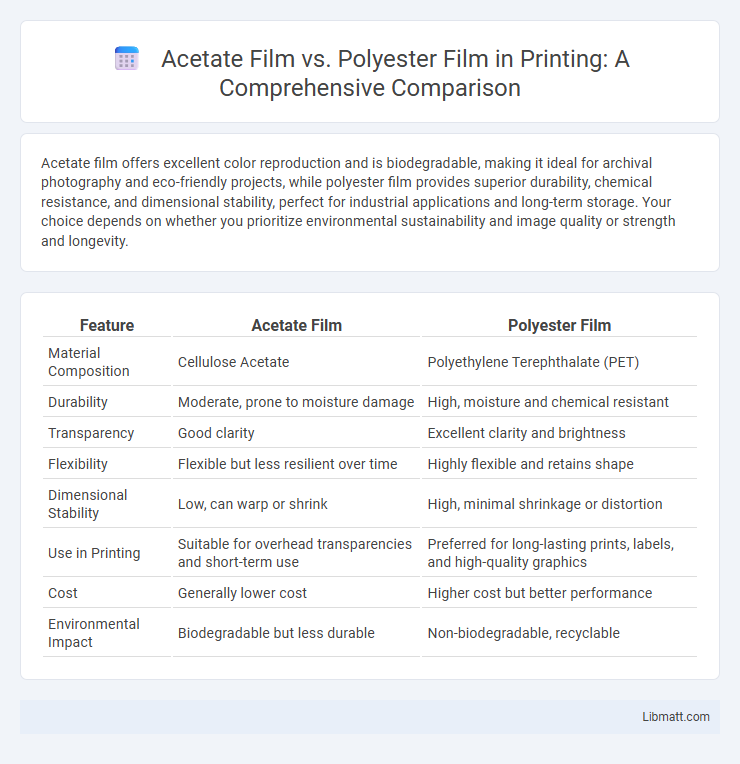Acetate film offers excellent color reproduction and is biodegradable, making it ideal for archival photography and eco-friendly projects, while polyester film provides superior durability, chemical resistance, and dimensional stability, perfect for industrial applications and long-term storage. Your choice depends on whether you prioritize environmental sustainability and image quality or strength and longevity.
Table of Comparison
| Feature | Acetate Film | Polyester Film |
|---|---|---|
| Material Composition | Cellulose Acetate | Polyethylene Terephthalate (PET) |
| Durability | Moderate, prone to moisture damage | High, moisture and chemical resistant |
| Transparency | Good clarity | Excellent clarity and brightness |
| Flexibility | Flexible but less resilient over time | Highly flexible and retains shape |
| Dimensional Stability | Low, can warp or shrink | High, minimal shrinkage or distortion |
| Use in Printing | Suitable for overhead transparencies and short-term use | Preferred for long-lasting prints, labels, and high-quality graphics |
| Cost | Generally lower cost | Higher cost but better performance |
| Environmental Impact | Biodegradable but less durable | Non-biodegradable, recyclable |
Introduction to Acetate and Polyester Films
Acetate film, known for its biodegradability and natural origin from cellulose, offers excellent transparency and is commonly used in photography and archival materials. Polyester film, a synthetic polymer, provides superior durability, chemical resistance, and dimensional stability, making it ideal for industrial applications and long-term storage. Your choice between acetate and polyester films depends on the specific needs for flexibility, lifespan, and environmental impact.
Chemical Composition and Structure
Acetate film is composed of cellulose acetate, a derivative of natural cellulose, featuring a semi-crystalline structure that offers moderate flexibility and biodegradability. Polyester film, typically polyethylene terephthalate (PET), has a fully synthetic polymer structure with a highly crystalline and stable molecular arrangement, providing superior mechanical strength and chemical resistance. The chemical composition of acetate film includes ester groups with hydroxyl functionalities, whereas polyester film consists of repeating terephthalate units linked by strong ester bonds, influencing their respective durability and thermal properties.
Physical Properties Comparison
Acetate film offers moderate flexibility and excellent clarity but is less durable and more prone to shrinkage compared to polyester film. Polyester film boasts superior tensile strength, higher resistance to moisture, heat, and chemicals, and maintains stability under varying environmental conditions. When selecting materials, your choice between acetate and polyester film should consider the need for long-term durability and dimensional stability.
Durability and Longevity
Polyester film offers superior durability and longevity compared to acetate film, resisting moisture, chemicals, and temperature variations more effectively. Acetate film is prone to degradation over time, including yellowing and brittleness, reducing its lifespan significantly. Choosing polyester film ensures Your materials maintain clarity and structural integrity for long-term use.
Clarity and Optical Performance
Acetate film offers excellent clarity with a natural warmth and good light diffusion, making it ideal for artistic or vintage-style presentations. Polyester film provides superior optical performance with higher transparency, greater dimensional stability, and resistance to shrinkage, ensuring sharp and consistent image clarity. Choose polyester film for applications requiring maximum precision and durability, while acetate film suits projects where aesthetic warmth matters to your visuals.
Environmental Impact and Biodegradability
Acetate film, derived from cellulose, features better biodegradability compared to polyester film, which is made from synthetic polymers and persists longer in the environment. The production of acetate film generally has a lower carbon footprint and relies more on renewable resources, whereas polyester film production depends heavily on fossil fuels, contributing to higher greenhouse gas emissions. Disposal of acetate film poses less environmental hazard due to its natural decomposition, while polyester film often accumulates as long-lasting plastic waste in landfills and oceans.
Common Applications in Industry
Acetate film is widely used in the photographic and film industries for motion picture and animation cels due to its clarity and ease of handling. Polyester film finds extensive applications in packaging, electronics, and magnetic media because of its superior strength, dimensional stability, and chemical resistance. In printing and industrial labeling, polyester film is preferred for its durability under harsh environmental conditions.
Cost and Availability
Acetate film typically has a lower initial cost but is less durable and less widely available compared to polyester film, resulting in potential higher long-term expenses. Polyester film offers superior strength, chemical resistance, and longevity, making it a cost-effective choice for applications requiring durability despite its higher upfront price. Availability of polyester film is generally better due to its widespread industrial use, whereas acetate film is less common and may be harder to source in large quantities.
Advantages and Disadvantages
Acetate film offers excellent clarity and is biodegradable, making it an eco-friendly option for photography and presentations, but it tends to be less durable and more prone to shrinkage and brittleness over time. Polyester film provides superior strength, chemical resistance, and dimensional stability, which ensures longevity and reliability for archival purposes, though it is non-biodegradable and more expensive. Choosing between acetate and polyester film depends on your need for environmental sustainability versus durability and long-term performance.
Choosing the Right Film for Your Needs
Acetate film offers excellent color reproduction and is biodegradable, making it ideal for archival and artistic purposes, while polyester film provides superior strength, dimensional stability, and chemical resistance suited for industrial and long-term use. Your choice depends on whether environmental sustainability or durability under mechanical stress is a priority. Polyester film is often preferred for applications requiring high tensile strength and heat resistance, whereas acetate film excels in applications needing vibrant image quality and eco-friendliness.
Acetate film vs polyester film Infographic

 libmatt.com
libmatt.com